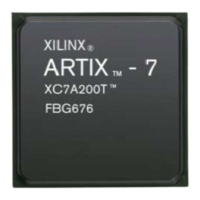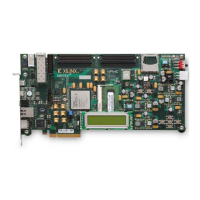Virtex-5 FPGA User Guide www.xilinx.com 373
UG190 (v5.0) June 19, 2009
Output Parallel-to-Serial Logic Resources (OSERDES)
Parallel Data Inputs - D1 to D6
All incoming parallel data enters the OSERDES module through ports D1 to D6. These
ports are connected to the FPGA fabric, and can be configured from two to six bits (i.e., a
6:1 serialization). Bit widths greater than six (up to 10) can be supported by using a second
OSERDES in SLAVE mode. See “OSERDES Width Expansion.” Refer to Figure 8-3,
page 356 for bit ordering at the inputs and output of the OSERDES along with the
corresponding bit order of the ISERDES_NODELAY.
Output Data Clock Enable - OCE
OCE is an active High clock enable for the data path.
Parallel 3-state Inputs - T1 to T4
All parallel 3-state signals enter the OSERDES module through ports T1 to T4. The ports
are connected to the FPGA fabric, and can be configured as one, two, or four bits.
3-state Signal Clock Enable - TCE
TCE is an active High clock enable for the 3-state control path.
Reset Input - SR
The reset input causes the outputs of all data flip-flops in the CLK and CLKDIV domains
to be driven Low asynchronously. OSERDES circuits running in the CLK domain where
timing is critical use an internal, dedicated circuit to retime the SR input to produce a reset
signal synchronous to the CLK domain. Similarly, there is a dedicated circuit to retime the
SR input to produce a reset signal synchronous to the CLKDIV domain. Because there are
OSERDES circuits that retime the SR input, the user is only required to provide a reset
pulse to the SR input that meets timing on the CLKDIV frequency domain (synchronous to
CLKDIV). Therefore, SR should be driven High for a minimum of one CLKDIV cycle.
When building an interface consisting of multiple OSERDES ports, all OSERDES ports
must be synchronized. The internal retiming of the SR input is designed so that all
OSERDES blocks that receive the same reset pulse come out of reset synchronized with one
another. The reset timing of multiple OSERDES ports is shown in Figure 8-20, page 381.

